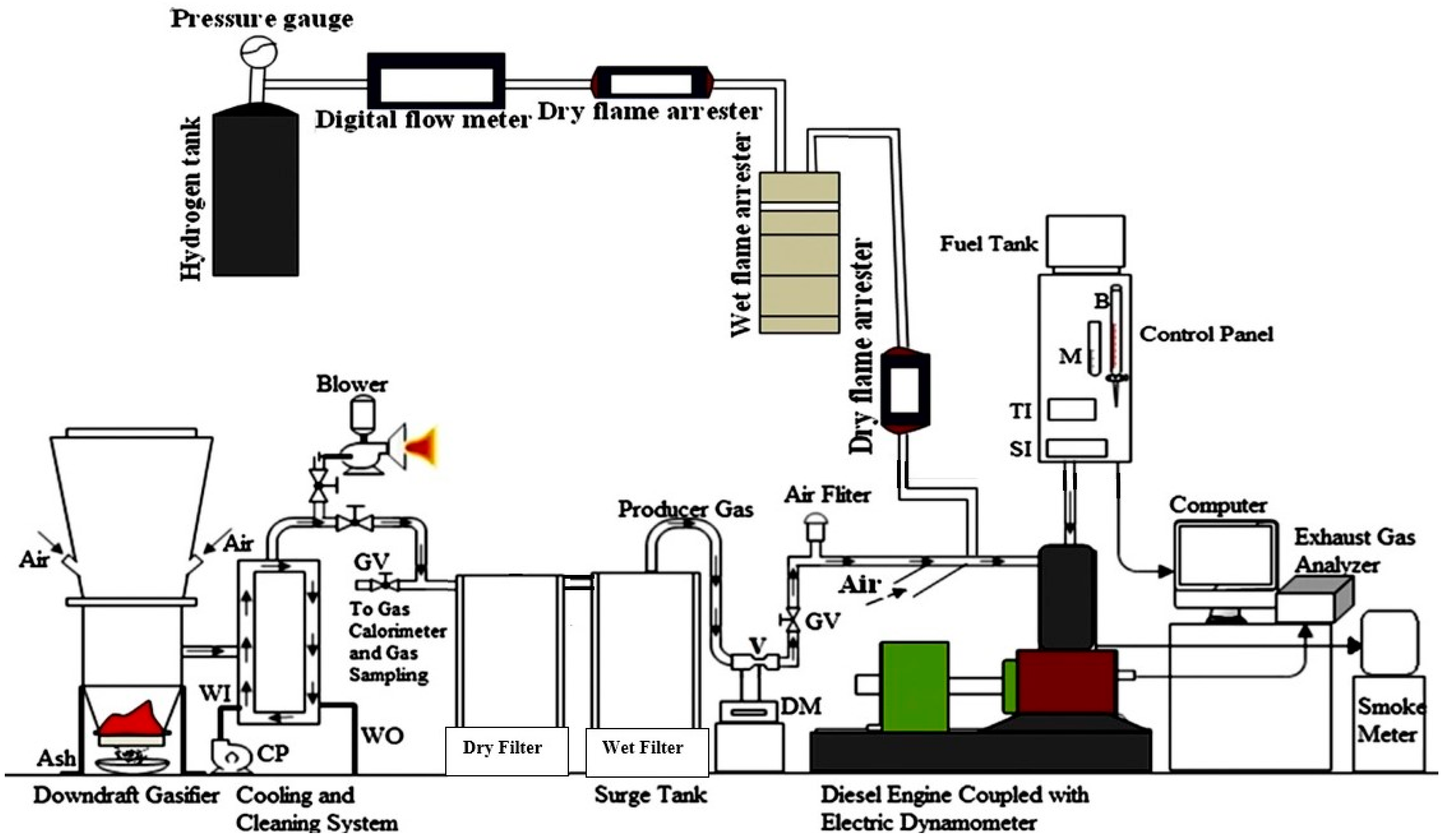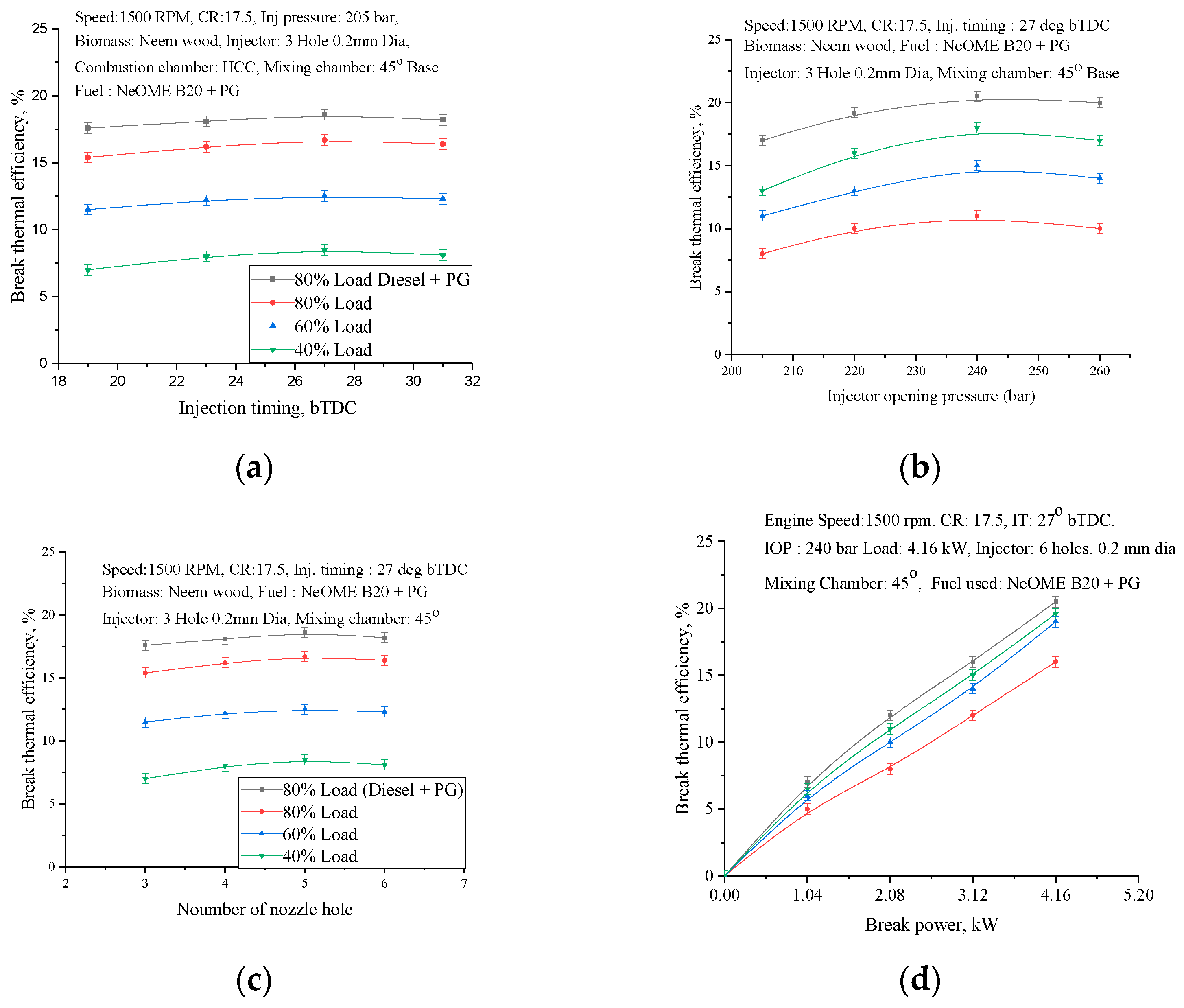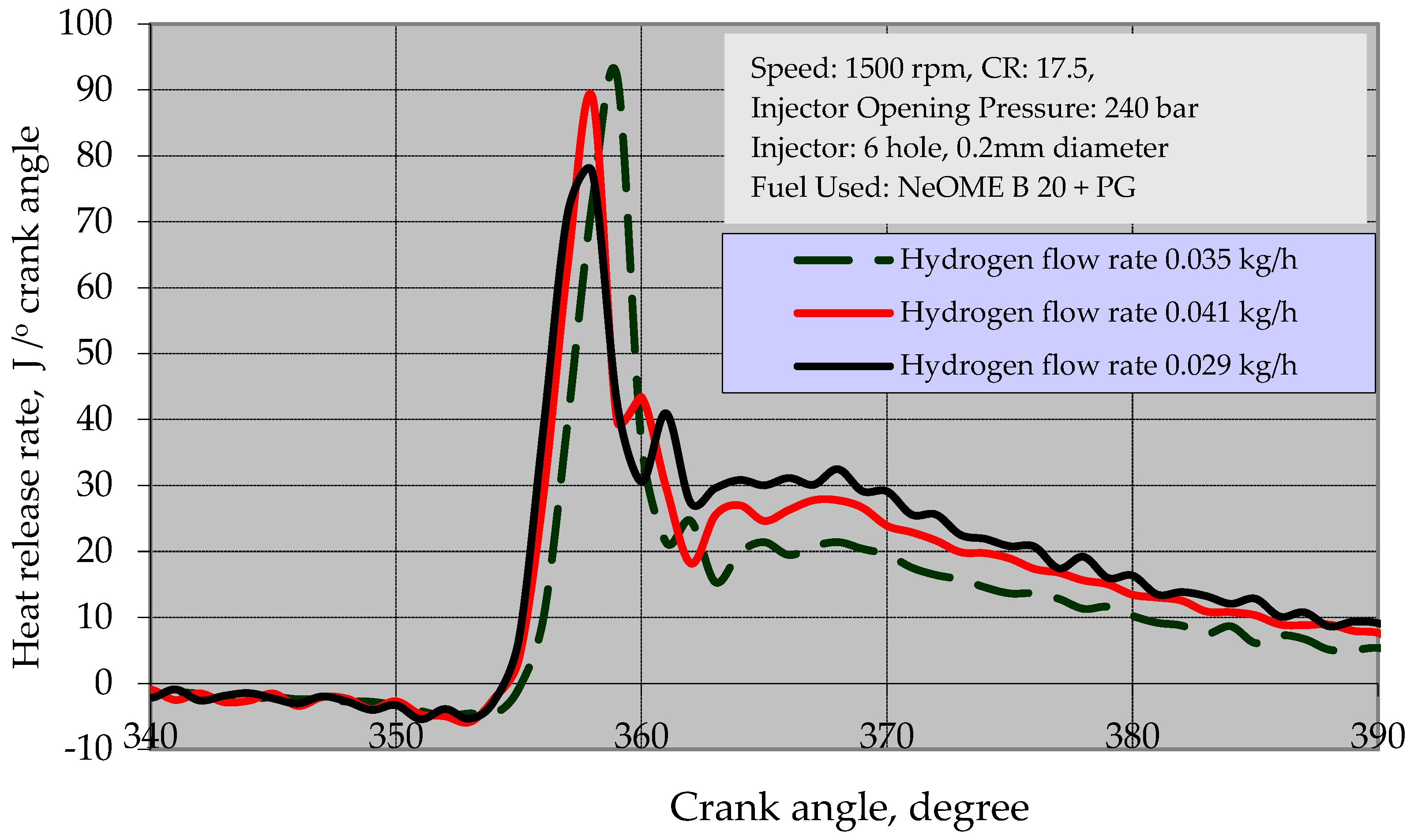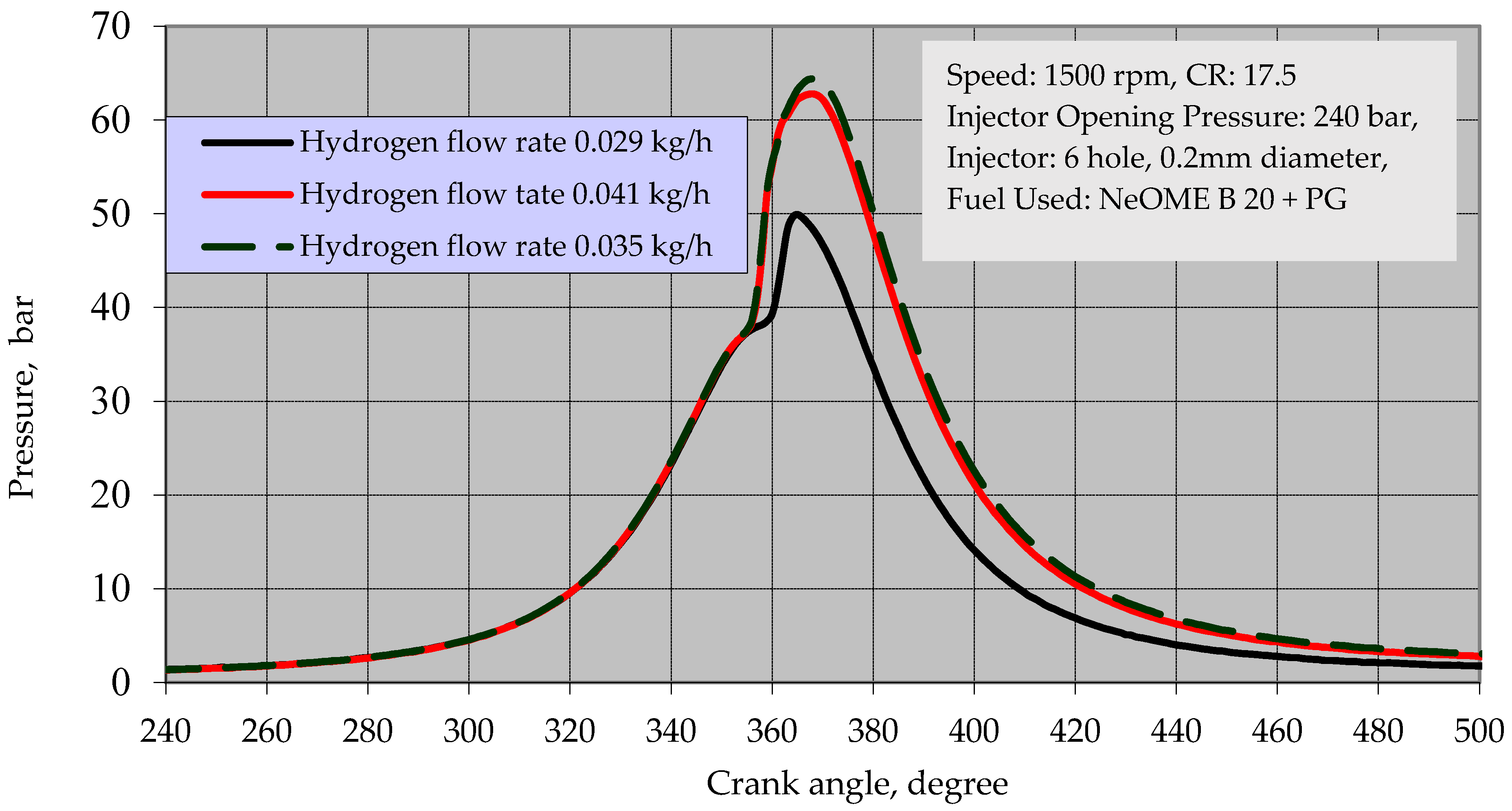1. Introduction
Energy is a basic source of day-to-day life. The rapid increase in population and standard of living compared to the last few decades has led to the instant growth of vehicles, industries, etc. Urban areas have started depending more on energy, ultimately causing a scarcity of resources for economic growth, thereby increasing fuel prices [
1]. Hence, the key to prevent energy crises is the utilization of alternative fuels, which play an important role in shaping the demand for energy [
2]. At present, biofuels are becoming more significant because of their renewable and biodegradable nature. Based on this circumstance, the use of renewable fuels for power generation plays an important role in meeting the demand of energy related requirements [
3]. Using biofuels and its blends, investigations have been carried out for the production of energy with natural air and hydrogen gas in dual fuel (DF) engines using different methods and approaches.
Several research studies have reported experimental works on the effect of hydrogen’s addition to low calorific value gaseous fuels for DF engine applications [
4,
5]. Hydrogen supplement in DF engines with other gaseous fuels such as liquefied petroleum gas (LPG), compressed natural gas (CNG), Biogas, and producer gas (PG) can significantly improve engine performance in terms of enhanced brake thermal efficiency (BTE) and reduce smoke, unburned hydro-carbons (UHCs), and CO considerably; moreover, further use of an increased compression ratio (CR) can positively impact engine performance, combustion, and vibrations [
6,
7,
8]. Advancement of injection timing from 19
o BTDC to 27
o BTDC showed a moderate improvement in the performance of DF engine fueled with Honge oil and its blend [
9]. Increasing IP up to 260 bar showed an improvement in BTE by 6% for the honge oil methyl ester–producer gas (HOME-PG) DF engine [
10,
11].
Most of the works reporting on DF engine performance using biodiesel and hydrogen-supplemented gaseous fuels have focused on optimizing the engine performance with a limited number of engine operating parameters such as fuel flow rates, speed, load, CR, IT, IP. However, the combined effect of various engine parameters on the DF engine’s performance, considering their simultaneous effects, has not been studied in detail. An investigation of DF engine performance which considers different and simultaneous operating parameters is the need of the hour.
Further, conducting huge experiments by varying multiple operating parameters becomes a tedious and time consuming process. Therefore, non-traditional techniques of computational and statistical analysis were used for the prediction of the engine performance [
5]. Nonlinear computer-based techniques such as the neural technique [
6], Fuzzy logics [
7], design of experiments (DOEs) [
8], etc., are used for evaluating the combined effects of multiple operating parameters on engine performance. The response surface methodology (RSM) technique enables the prediction of engine performance at different engine operating parameters through validation with experiment test results [
9]. Pandian et al. considered the design of experiments (DOEs) technique as one of the better techniques with which to study the combined effect of operating parameters on engine performance [
12]. The optimization of the combined effects of multiple operating parameters on DF engine performance using RSM with DOEs is a feasible approach which simaltaneously provides a clear understanding of engine performance and emission characteristics [
13]. The RSM technique helps to reduce the number of experimentations by providing a better combination of input parameters. RSM is a proven technique which is has been used by several researchers in internal combustion (IC) engine studies [
14]. Experiments carried out by Dhole et al. to optimize DF engine performance when operating on diesel and hydrogen achieved a close proximity of 95% by using DOEs and multiple regression analysis [
15]. Hirkude et al. used RSM modeling to optimize values of IT, injector opening pressure (IOP), and CR as 27.8
obTDC, 250 bar, and 17.99, respectively, on the performance of engines operating with waste fry oil methyl ester–diesel (WFOME-Diesel) blends with a maximum desirability of 0.778 [
16]. Pandian et al. reported improved engine performance with optimized IT, IOP, and nozzle geometry using the RSM method. Accordingly, 21°bTDC, 225 bar, and a 2.5-mm nozzle hole, respectively, have shown a desirability index of 0.98 [
17]. Atmanli et al. optimized the blending condition of bio-diesel and diesel by using RSM and reported a reduction in NOx, HC, and CO emission levels under full load condition [
18]. Simsek et al. [
19] reported on engine performance using canola, sunflower, and vegetable oils with RSM technology and achieved a confidence level of 95%, with input parameters including engine load, IP, and the blending of fuels. Singh et al. [
20], using the RSM approach, obtained an optimal condition with 15°bTDC IT, 47% engine load, and 221 bar IP. Sharma et al. [
21] achieved improved efficiency and recued emission levels by optimizing parameters such as the blending ratio of biodiesel, engine load, flow rate of air, and speed of the DF engine. The optimized parameters were reported to be 8% for the biodiesel blend, 6.2 kg load, 49.5 mm of air flow rate, and a 1486 rpm speed. Rith et al. reported a desirability of 82.3% with input parameters such as IT, gas flow rate, and engine load on the DF engine performance with jatropha-derived biodiesel and PG [
22].
Many research studies have highlighted the simultaneous optimization of engine operating parameters such as IT, IOP, CR, NG, engine load and fuel blending ratio. However, the present research work focuses on the simultaneous effect of the flow rates of NeOME B20, PG, and hydrogen (H2) on engine performance using RSM technology. Hence, an attempt is made to optimize the fuel flow rate of NeOME B20, PG, and H2 to improve DF engine performance and emission characteristics using the RSM technique.
2. Material and Methods
This section discusses the materials and methodology adopted to determine DF engine performance.
2.1. Test Fuels
Table 1,
Table 2 and
Table 3, respectively, list the characteristics of the fuels used in the current experiment.
2.2. Experimental Setup and Experimentation
2.2.1. Experimental Setup
A suitably modified DF engine made from an existing single cylinder, four-stroke, water cooled, natural aspiration engine was used as shown in the
Figure 1. Specification of engine used in this study is detailed in
Table 4. Special arrangements were made for the induction of gaseous fuels as shown in
Figure 1. The compression ignition (CI) engine was integrated with downdraft gasifier, along with different accessories such as air filters and with wet and dry filters for addressing the tar issues of the producer gas. Engine was operated at a constant speed of 1500 rpm. A 6-hole nozzle with a 0.2-mm diameter orifice size was used for pilot fuel injection using a conventional mechanical fuel injection system with a maximum injection pressure of 260 bar. The engine maker specified the IT as 23
obTDC, IOP as 205 bar, and the compression ratio as 15.7, respectively. To achieve improved engine performance, these were optimized for the combined use of biodiesel, producer gas, and hydrogen gaseous fuels. Eventually, the optimal values of the 240 bar injection pressure, 17.5 CR, and 27
obTDC IT were determined for experimentation. A suitable mixing chamber was employed for the homogeneous mixing of air and PG–hydrogen mixtures for the engine input. The engine’s tailpipe emissions were monitored once it reached steady state. Hydrogen gas stored in cylinder at a pressure of 150 bar was let into the injector by reducing its pressure to 1 bar using a pressure regulator and was then allowed to pass through a non-return valve. A flow meter was used to measure the flow rate of Hydrogen gas. This was further combined with an air-producing gas mixture by injecting the hydrogen into the inlet manifold of the engine.
For the safety aspects of engine operation, dry and wet flame arresters were utilized in the hydrogen lines. The flame arrester acts as non-return valves and prevents the back flow of the hydrogen flame reaching the gas cylinder. Initially, experiments were performed using single fuels of diesel, biodiesel, and its B20 blend for baseline data generation. Later, experiments were performed in DF engine modes using producer gas and hydrogen along with the selected pilot fuel of biodiesel injection.
2.2.2. Experimentation
The DF engine test rig is designed to accommodate three fuel combinations of NeOME biodiesel, producer gas, and hydrogen, respectively. NeOME biodiesel was injected at an optimized injector opening pressure (IOP) of 240 bar and at an advanced IT of 27
oBTDC, and the gaseous fuels of the producer gas and hydrogen were inducted at varied flow rates using flow control valves. After advancing the fuel IT from 19 to 27
oBTDC, DF engine performance initially improved and then (31
oBTDC) deteriorated, as shown in
Figure 2a. BTE at 27
oBTDC increased due to an increased delay period as time available for the air–fuel mixing increased. Similarly, as the IOP of NeOME increased from 200 to 240 bar, the BTE improved while emissions reduced, beyond which (260 bar) the engine performnce deteriorated, as shown in
Figure 2b. This is due to the improved atomization of the NeOME biodiesel at 240 bar and the resulting uniform air–fuel mixture. Further, a 6-hole injector and a compatible and Lateral Dual Swirl combustion chamber (LDSCC) was used to further optimize the DF engine performance, as shown in
Figure 2c,d respectively. All optimized parameters of IT (27
oBTDC), IOP (240 bar), the number of injector holes (6), the and combustion chamber (LDSCC) were maintained as constant to facilitate further experimentation on the DF engine’s performance.
With the above optimized engine parameters, exhaustive engine experiments were conducted on the DF engine, in which the pilot fuel of the NeOME B20 flow rate varied from 0.4 to 0.8 kg/hr. The gaseous fuels of the producer gas and hydrogen varied from 7to 9 kg/h and 0.029 to 0.059 kg/h, respectively. The higher calorific value of carbon-free hydrogen gas enhanced the performance of the dual engine fuel when used along with producer gas induction.
2.3. Uncertainty Estimation
Table 5 shows the magnitudes of uncertainty in the measurement of the different parameters of the experimental studies.
2.4. Design of Experiments
The DOEs technique enables one to study the performance of a DF engine regarding the influence of different variables simultaneously. The DOEs technique aids in reducing the number of experimental tests to be conducted while maximizing time efficiency and minimizing fuel material use [
21,
22,
23].
Three parameters—the flow rates of the NeOME B20, PG, and H
2 fuels —are taken into consideration in the current work, and the ranges of these flow rates are chosen based on preliminary engine studies.
Table 6 shows the flow parameters of liquid and gaseous fuels, respectively.
Table 7 represents the design of the experimental plan adopted in the work.
Proper planning of the experiments is required for the generation of regression models using experimental data. The simplest experimental design for collecting observations is the full factorial design (FFD). In the present study, the flow rates of the NeOME B20, PG, and H
2 fuels are considered as controlling factors, with three levels defined for each of the factors, as shown in
Table 7. Thus, with k = 3 and l = 3, the minimum number of trials is Nmin = l
k = 27 for full factorial design. Accordingly, 27 experiments were conducted, and the experimental results were recorded. These experimental results were further used to develop the mathematical models using regression analysis. The models developed were then used to analyze the interaction effects of the process parameters on the proposed performance measures [
24,
25].
2.5. Response Surface Modeling
With corresponding input variables, the empirical mathematical modeling of responses is fitted. Equation (1) specifies the quadratic model based on RSM [
23].
The surface Z, which includes linear, nonlinear, and Xi’s interactions, is represented by Equation (1), where
Co = Coefficient and is a constant,
Ci = Coefficient which includes all linear terms,
Cii = Coefficient and are quadratic terms,
Cij = Coefficients are the interaction terms.
The regression model and coefficients are determined as per the literature [
26]:
where
X = Calculation matrix, which includes linear, quadratic and interaction terms.
The developed models obtained through multiple regression analysis are obtained using
XT = Transpose of X.
Z = the matrix of desired characteristic.
In these Equations (3)–(11), NeOME B20 (A) is in kg/h, PG (B) is in kg/h, H2 (C) is in kg/h; BTE is in %; smoke is in HSU; HC is in ppm; CO in %, NOx is in ppm, Pmax is in bar, ID is in °CA, CD °CA, and heat release rate (HRR) is in J/°CA.
The Fisher (F) test [
23] was utilized in the current study to assess the suitability of the fitted RSM-based models, and it was determined to be acceptable at a 1% impact level.
Table 8 presents an analysis of variance (ANOVA) summary [
23].
Equation (12) provides the response surface model accuracy:
where
yi,expt: Measured value of performance characteristic corresponding to ith trial.
yi,pred: RSM predicted value of performance characteristic corresponding to ith trial.
n: number of trials in FFD.
Using the experimental data provided in FFD, Equations (3)–(11) were developed to test the accuracy of the models.
Equations (3)–(11) are utilized to forecast the concerned characteristic by replacing the effects of the flow rates of three fuels, namely, NeOME B20 (pilot fuel), PG (induction), and H2 (injection), within the ranges of the stated parameters.
4. Conclusions
In the current study, RSM was used to analyze the impacts of the fuel flow rate on the engine performance, emission, and combustion characteristics of biodiesel, PG, and hydrogen. This study is innovative in that it optimizes the fuel flow rate of a DF engine using RSM’s NeOME B20-PG+H2 fuel mixes. Biodiesel, PG, and hydrogen flow rates were chosen for the RSM as input factors, and BTE, smoke, HC, CO, NOx, Pmax, ID, Cd, and HRR were chosen as the output parameters. With confidence levels of 95%, all statistical models created by RSM from test data for the performance and emission attributes were found to be significant. R2 values were determined to be 0.9986, 0.9985, 0.9985, 1.000, 0.9974, 1.000, 0.9923, 0.9895, and 0.9996 for BTE, smoke, HC, CO, NOx, Pmax, ID, and HRR, respectively. According to the RSM results, the best engine operating factors for the biodiesel, PG, and hydrogen fuel flow rates were discovered to be 0.8, 7, and 0.044 kg/h, with the best responses being 23.75%, 30 HSU, 32 ppm, 0.31%, 225 ppm, 61 bar, 16°CA, 28°CA, and 78 J/°CA for BTE, smoke, HC, CO, NOx, Pmax, ID, Cd, respectively.
The DF technology is well established and can accommodate different fuels simultaneously. The limitation of the work reported refers to use of lower injection pressures of pilot fuel quantity. This can be suitably overcome by adopting an electronic control unit (ECU)-enabled, high-pressure injection system with a common rail direct injection facility (CRDI). In this facility, typical injection pressures ranged from 600 to 1200 bar.





















